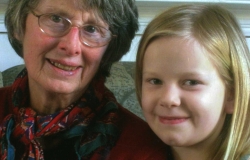 Mary Fawcett is the author of Learning Through Child Observation, published by Jessica Kingsley Publishers. She is also an early years consultant and an evaluator for 5x5x5=creativity, an arts-based research organisation.
Mary Fawcett is the author of Learning Through Child Observation, published by Jessica Kingsley Publishers. She is also an early years consultant and an evaluator for 5x5x5=creativity, an arts-based research organisation.
How did you become interested in Early Childhood Studies?
I decided to become a teacher of young children (as a school leaver) largely because I liked the idea of sharing my enthusiasms, such as music, gardening, literature, scientific ideas, painting, making and cooking. In fact I was able to do all these things as a teacher in the 1950s and 60s. While my children were young I was deeply involved in the early days of the playgroup movement. Through this I learned about adult learning, community development and different forms of provision. With each new experience my fascination with children’s early development increased. Since then the rapid growth in research in the area of Early Childhood Studies has continued to feed my curiosities.
How has the field of child observation has changed since 1996 when the first edition of Learning Through Child Observation was published?
At the time of the first edition I was lecturing on Social Work courses and was surprised at how little preparation there was for these students in terms of observation skills and knowledge of child development. There was a clear gap in the market for students’ books and especially a book for the variety of professional groups concerned with young children. To-day there are many books on observation, but they still tend to concentrate on specific professional groups. The government’s more joined up approach to children’s services now means there is an ever greater need for a multi-professional approach. Though the rhetoric is all about ‘every child matters’, personalisation etc, I feel that prescriptive, goal-driven approaches may have diminished open-minded observation and led to less sensitive understanding. Another factor, addressed in the second edition, is the changing view of children. Through my work with 5x5x5=creativity, as well as personal observations of three grandchildren, over the last few years I have become much more alert to the dynamic capacities of all young children and conscious of how they are underestimated. The second edition also demonstrates the importance of the many forms of communication children use to express their feelings and ideas.
The new edition of your book includes insights from your work with the arts based educational project 5x5x5 = creativity. Can you tell us more about the organisation?
5x5x5=creativity is an arts-based educational research project that has been evolving over the last 9 years. The name came from the first cohort of five early year’s settings working with five artists in collaboration with five cultural centres (galleries, theatre, music centre, etc). The project is concerned with creativity in its broadest sense – Anna Craft calls this ‘life-wide’ creativity – where open-minded problem-solving can be used in all kinds of situations. My observations of hundreds of children through this project has opened my eyes to their brilliant imaginations and their ability to share their fascinations with others through the ‘hundred languages of children’ i.e. through drawing, moving, music, and many other modes as well as talking. This is an important matter since talking, reading and writing tend to overshadow all these other forms. See the website.
What do you think are the main challenges/attractions of working in Early Years settings?
What was the last book you read and what are you reading at the moment?
The current book I’m reading (and its taking a long time!) is Charles Dickens’ Little Dorrit.
Copyright © Jessica Kingsley Publishers 2009